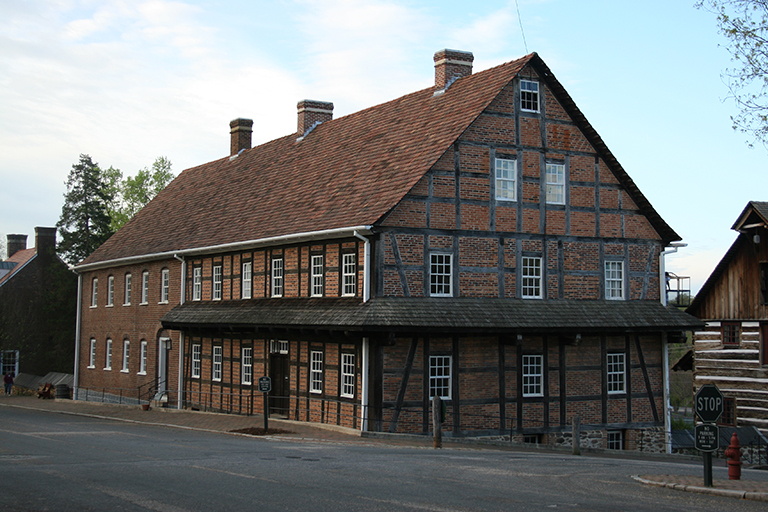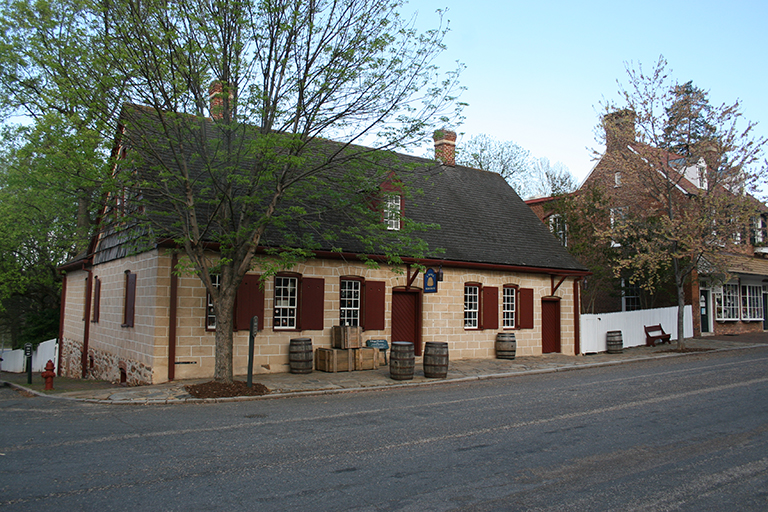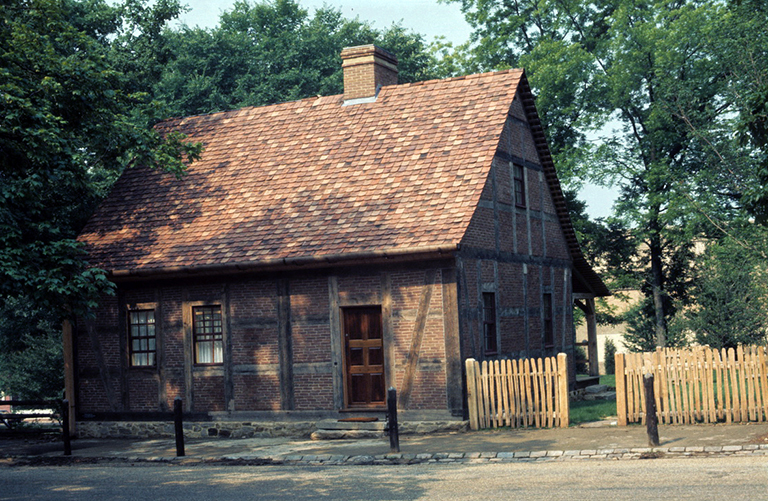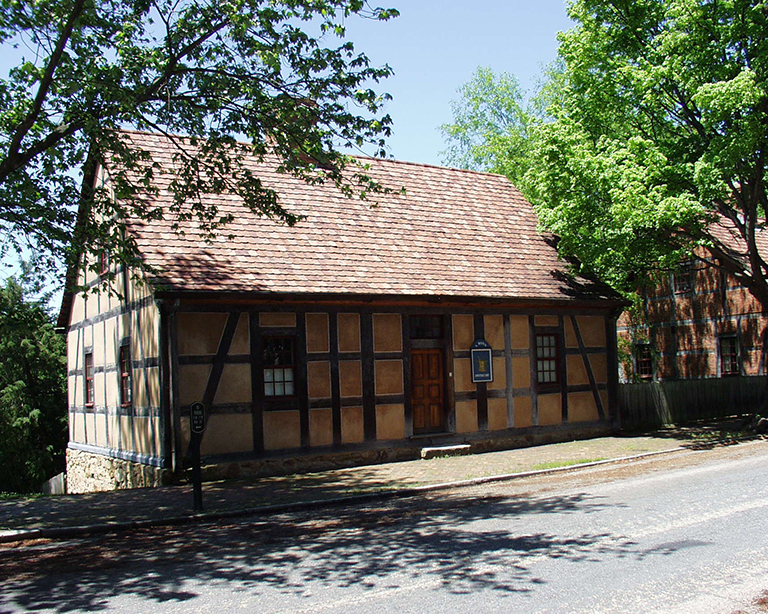Rasp, Melchior (1715-1785)
Birthplace:
Salzburg, Austria
Residences:
- Bethabara, North Carolina
Trades:
- Stonemason
- Brickmason
NC Work Locations:
Building Types:
Melchior Rasp (January 8, 1715-March 19, 1785), master mason in Bethabara and Salem, North Carolina, was among the few European-born building artisans in colonial North Carolina whose buildings survive to illustrate the direct transplantation of Old World traditions. From 1754 until 1784 Rasp played a central role in the early architecture of the Moravians in the Wachovia settlement in piedmont North Carolina. His best known work is the Single Brothers House in Salem, a nationally important example of traditional European fachwerk (half-timbered) construction.
Melchior Rasp was born in Salzburg, Austria. He worked in the salt works as a youth, then moved to Holland at age fifteen, and subsequently moved to Frankfurt-am-Main where he learned the mason’s trade. In the early 1740s he settled in the Moravian town of Herrnhaag, joined the Moravian congregation, and worked as a mason for several years. In 1750 he departed for Bethlehem, Pennsylvania, the important Moravian community, where he stayed for five years, with his major work being Nazareth Hall, a massive masonry school building. (See Frederic William Marshall for more on Wachovia.)
In 1753 the Moravians purchased the Wachovia tract in piedmont North Carolina and began their colony there. Development and operation of the Moravian communities were guided by the Moravian leaders in Bethlehem and Herrnhut and by local governing boards who kept extensive records and sent accounts to the leadership in Pennsylvania and Europe. Carefully selected men with diverse skills arrived in Wachovia November 1753 to make a start on the settlement at the place they named Bethabara. Others came as the community developed, including the first married couples in October, 1755. Melchior Rasp arrived on November 4, 1755, a few days after carpenter Christian Triebel, and his masonry skills were quickly put to use. The “diary” in the Records of the Moravians for December 1, 1755, noted, “During the first half of the month [November] work was pushed on the new house; Pfeiffer and Melchior Rasp, who had been breaking stone, were appointed to build the wall.”
In 1765 the Moravian leadership including Frederic William Marshall selected the site for the new town of Salem as the main community in the Wachovia settlement, and in 1766 Melchior Rasp was one of the eight men selected to move there to commence construction. Many of the materials were prepared at Bethabara’s workshops and sent to Salem. The “Bethabara Diary” in the Moravian Records, noted that on February 10, 1766 “a company of Single Brethren were selected to begin active work in Salem and would have gone thither at noon,” but a heavy snow delayed their journey. On February 19, “eight men moved to Salem to remain there for a time and make a real beginning with building. They were Georg Holder, Steiner, Ziegler, Melchior Rasp, Petersen, Praezel, Jens Schmid and Birkhead. . . . Our two wagons took tile, brick, bedding, and an outfit for cooking.” (In contrast to the North Carolina tradition of roofing with wooden shingles, the Moravians employed clay tiles, made by the potter, to roof their principal buildings whenever possible.) Rasp’s memoir, a record of his life in the Moravian records, noted, “When the building of Salem was begun, he moved thither with the first Brethren and was the master mason in all the work of that town including the Gemein Haus and the [Single] Brothers House. One could be certain that he intended his work to be useful and permanent.”
In Salem, Rasp and other workmen erected a series of initial buildings in traditional European fachwerk (half timbering) that included the relatively small “First,” “Second,” “Third” “Fourth” and “Fifth” houses as well as the large Single Brothers House and the Gemeinhaus (Salem), the combination church and meeting place. The Fourth House and the Single Brothers House still stand, restored to their eighteenth century appearance. In 1772 the initial construction phase of Salem was completed and the administration of Wachovia moved from Bethabara to Salem, which was ready for the first permanent residents.
As master mason, Rasp was responsible for all the stone and masonry construction in Salem and was assisted by apprentices or untrained local workers as available. On April 9, 1777, for example, the tailor and night watchman Henry Zillman was appointed to help Rasp in placing a tile roof on the Gemeinhaus in Salem. Rasp also built masonry foundations and chimneys for numerous buildings, such as the 1771 Miksch House, a log structure covered with clapboards, which was the first residence for a single family in Salem. Rasp also built key buildings in other Moravian communities in Wachovia, including the 1770 Gemeinhaus (Bethania) in the town established in 1759, and the 1777 tannery in Bethabara.
Rasp was plagued with physical mishaps caused in part by the nature of his trade. His health was permanently damaged on one of his trips between Bethabara and Salem during construction of the latter town when he fell and drove a pipe stem through the roof of his mouth, a wound that incapacitated him for seven weeks. In 1778, when he was working on a new distillery in Salem, he lost an eye in an accident involving a stone chip, and the injury plagued him until his death and left him nearly blind. Rasp’s expertise continued to be invaluable to the community. He served as a member of the waterworks planning committee, and he was appointed as one of Salem’s fire inspectors to check fireplace, stove, and chimney construction and use.
Even as his age and infirmities took their toll, the community still relied heavily on Rasp as master mason because there was no one to replace him. In 1779 he was given the assistance of Brother Heckewelder in building the foundations of wood sheds for the Salem Gemeinhaus and Single Sisters House and other tasks. On May 23, 1780, the records noted, “It might help the walls [of the Second House, a half-timbered structure] to plaster them on the outside if we had someone who could do it for Br. Rasp is too old for such work.” Three months later, “At this time it is to be considered that Melchior Rasp is to have a hod carrier so that his work will be easier and cheaper.” On March 20, 1781, to help solve the chronic shortage of masons in Salem, Johann Gottlob Krause was released six months early from his apprenticeship as a potter to enable him to learn the mason’s trade from Rasp. In October, 1782, after an 18-month apprenticeship, Krause was designated a journeyman with Rasp his master.
By 1784 Rasp could no longer meet the demands of the position of master mason. In a letter of February 15, 1784, Salem administrator Frederic William Marshall lamented, “We are handicapped by the lack of workmen. Our master carpenter, Trieble [Triebel], is in his seventieth year and our master mason Melchior Rasp in his sixty-eighth year, and both are in the sick room. The latter is no longer able to serve at all.” In December, 1784, Krause was named master mason, and Rasp died the following March 19, leaving Krause on his own with only four years of training as a mason. For thirty years Rasp had used traditional skills to build the first generations of substantial buildings in Salem, which defined its early character. Krause would combine what he had learned from Rasp with other techniques to construct the next generation of masonry buildings.
- Erika Huber, unpublished translations of Moravian records made for Old Salem, Inc., also on file at the Archives of the Moravian Church in America, Southern Province, Winston-Salem, North Carolina.
- Adelaide L. Fries and Douglas L. Rights, Records of the Moravians, 1-9 (1922-1943).
- Edward Schwarze, unpublished translations of Moravian records made for Old Salem, Inc., also on file at the Archive of the Moravian Church in America, Southern Province, Winston-Salem.
- Minnie J. Smith and Kenneth Hamilton, Records of the Moravians, 10 and 11 (1947-1949).
Builders' House
Contributors:Melchior Rasp, mason; Christian Triebel, carpenterDates:1766
Location:Winston-Salem, Forsyth CountyStreet Address:Salem, Winston-Salem, NC
Status:No longer standing
Type:Residential
Images Published In:Gwynne Stephens Taylor, From Frontier to Factory: An Architectural History of Forsyth County (1981).
Community Store
Contributors:Variant Name(s):T. Bagge Store and House
Dates:1775
Location:Winston-Salem, Forsyth CountyStreet Address:626 S. Main St., Old Salem, Winston-Salem, NC
Status:Standing
Type:Commercial
Note:The first stone building in Salem, the 1 1/2-story structure has two entrances reflecting its initial purpose as combination store and storekeeper’s residence. It is of rough stonework stuccoed and scored to resemble stone blocks.
Distillery
Contributors:Melchior Rasp, masonDates:1776
Location:Bethabara, Forsyth CountyStreet Address:Bethabara, NC
Status:No longer standing
Type:Industrial
Fifth House
Contributors:Melchior Rasp, mason; Christian Triebel, carpenterDates:1768; 1977 (reconstructed)
Location:Winston-Salem, Forsyth CountyStreet Address:434 S. Main St., Winston-Salem, NC
Status:Reconstructed
Type:Residential
Note:This was the final exposed, half-timbered building in this block of the initial buildings built in Salem.
First House
Contributors:Dates:1767
Location:Winston-Salem, Forsyth CountyStreet Address:S. Main St., Winston-Salem, NC
Status:Reconstructed
Type:Residential
Images Published In:Hunter James, Old Salem Official Guidebook (1982).
Fourth House
Contributors:Dates:1768
Location:Winston-Salem, Forsyth CountyStreet Address:438 S. Main St., Winston-Salem, NC
Status:Standing
Type:Residential
Images Published In:Catherine W. Bishir, North Carolina Architecture (2005).
Hunter James, Old Salem Official Guidebook (1982).Note:The restored Fourth House is the only original example of the small fachwerk houses built in Salem’s initial building campaign.
Gemeinhaus (Bethania)
Contributors:Melchior Rasp, masonDates:1770
Location:Bethania, Forsyth CountyStreet Address:Bethania, NC
Status:No longer standing
Type:Religious
Note:Fries, Records of the Moravians, vol. I (reprint, 1968), contains a sketch of Bethania that depicts the 2-story Gemeinhaus standing next to the later brick church.
Gemeinhaus (Salem)
Contributors:Dates:1769-1771
Location:Winston-Salem, Forsyth CountyStreet Address:Old Salem, Winston-Salem, NC
Status:No longer standing
Type:Religious
Miksch House
Contributors:Melchior Rasp, masonDates:1771
Location:Winston-Salem, Forsyth CountyStreet Address:532 S. Main St., Winston-Salem, NC
Status:Standing
Type:Residential
Note:The modest log dwelling, covered in weatherboards, was the first residence built for a single family in Salem. It features the characteristic Germanic central chimney with a cooking fireplace.
Pottery
Contributors:Dates:1768
Location:Winston-Salem, Forsyth CountyStreet Address:Salem, Winston-Salem, NC
Status:No longer standing
Type:Industrial
Second House
Contributors:Dates:1767
Location:Winston-Salem, Forsyth CountyStreet Address:S. Main St., Winston-Salem, NC
Status:No longer standing
Type:Residential
Single Brothers House
Contributors:Frederic William Marshall, architect; Melchior Rasp, stonemason and brickmason; Christian Triebel, carpenterDates:1768-1769
Location:Winston-Salem, Forsyth CountyStreet Address:600 S. Main St., Old Salem, Winston-Salem, NC
Status:Standing
Type:Industrial
Religious
ResidentialImages Published In:Catherine W. Bishir, North Carolina Architecture (2005).
Catherine W. Bishir and Michael T. Southern, A Guide to the Historic Architecture of Piedmont North Carolina (2003).
Hunter James, Old Salem Official Guidebook (1982).Note:The massive, half-timbered initial section of the building, among the first permanent structures erected in Salem, is one of the finest examples of fachwerk in the United States. It was planned and built by men trained in Europe. It recalls the “choir” system by which the early Moravian community was organized, by age, gender, and marital status. The Single Brothers House included workshops as well as living quarters. A log workshop at the rear has been reconstructed from written and archeological information. The large building incorporates such traditional construction techniques as fachwerk (half-timbering) and a tile roof.
Tannery
Contributors:Melchior Rasp, mason; Christian Triebel, carpenterDates:1769
Location:Winston-Salem, Forsyth CountyStreet Address:Winston-Salem, NC
Status:No longer standing
Type:Commercial
Note:This was part of the Single Brothers’ Industrial Complex which included various buildings supporting a range of uses. The Tannery was north of the current Academy Street where the adjacent creek provided a source of water for its operations.
Third House
Contributors:Dates:1767
Location:Winston-Salem, Forsyth CountyStreet Address:S. Main St., Winston-Salem, NC
Status:Reconstructed
Type:Residential






